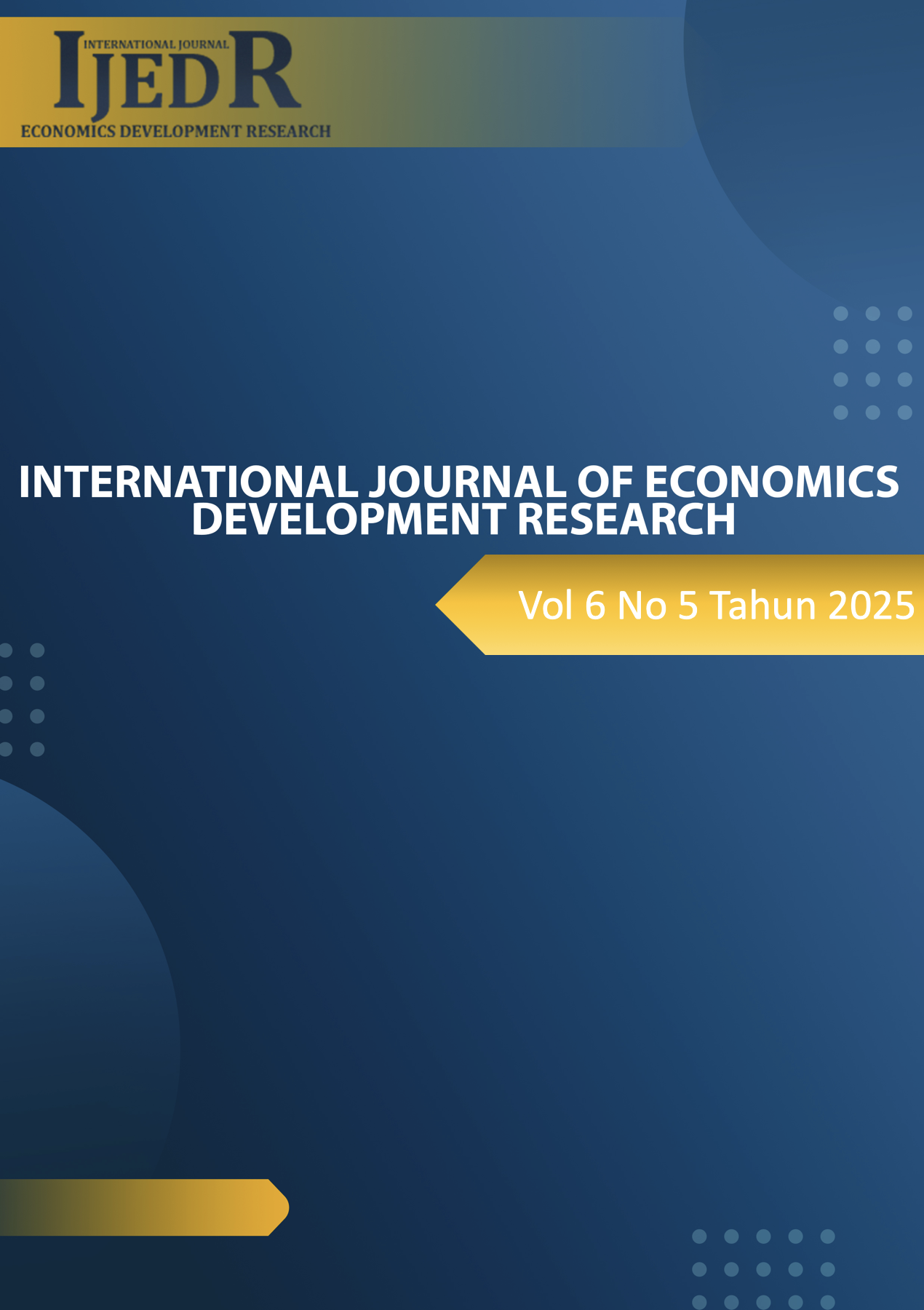Unveiling Tomorrow's Labor Market: A Data-Driven Forecast of Open Unemployment in Bandung Regency (2025–2029)
DOI:
https://doi.org/10.37385/ijedr.v6i6.8681Keywords:
Forecasting, Unemployment, ARIMA, Bandung RegencyAbstract
This study aims to project the Open Unemployment Rate (OUR) in Bandung Regency for the 2025–2029 period. Unemployment is a crucial issue that reflects economic health and social welfare, making accurate forecasting a vital instrument for regional development planning. Utilizing annual time-series data of OUR from the Central Statistics Agency (BPS) for the period 2007–2024, this research applies the Box-Jenkins methodology through the Autoregressive Integrated Moving Average (ARIMA) model. The analysis process includes stationarity tests, model identification, parameter estimation, and diagnostic checking. The model selection results, based on the lowest Akaike Information Criterion (AIC) and Bayesian Information Criterion (BIC), indicate that ARIMA(0,1,1) is the most parsimonious model. The resulting projection indicates a very significant downward trend in the OUR, from 6.36% in 2024 to 3.21% in 2029. Although this projection is highly optimistic, the volatility of the historical data and the univariate nature of this model imply that the realization of this trend is highly dependent on economic stability and the effectiveness of sustained policies to address structural employment issues.
Keywords: Forecasting, Unemployment, ARIMA, Bandung Regency
References
Adely, F. I. J., Mitra, A., Mohamed, M., & Shaham, A. (2021). Poor education, unemployment and the promise of skills: The hegemony of the “skills mismatch” discourse. International Journal of Educational Development, 82, 102381. https://doi.org/10.1016/j.ijedudev.2021.102381
Adipratomo, Y., Hutagaol, P., & Tanjung, D. (2024). Penyebab tingginya angka pengangguran di Jawa Barat. SEIKAT: Jurnal Ilmu Sosial, Politik Dan Hukum, 3, 158–165. https://doi.org/10.55681/seikat.v3i2.1274
Ahn, H. J., & Hamilton, J. D. (2022). Measuring labor-force participation and the incidence and duration of unemployment. Review of Economic Dynamics, 44, 1–32. https://doi.org/10.1016/j.red.2021.04.005
Axtell, R. L., Guerrero, O. A., & López, E. (2019). Frictional unemployment on labor flow networks. Journal of Economic Behavior & Organization, 160, 184–201. https://doi.org/10.1016/j.jebo.2019.02.028
Bougrine, H. (2020). Credit, Money and Crises in Post-Keynesian Economics. Edward Elgar Publishing. https://doi.org/10.4337/9781786439550.00016
Cairó, I., Fujita, S., & Morales-Jiménez, C. (2022). The cyclicality of labor force participation flows: The role of labor supply elasticities and wage rigidity. Review of Economic Dynamics, 43, 197–216. https://doi.org/10.1016/j.red.2021.02.001
Darmawan, A. S., & Mifrahi, M. N. (2022). Analisis tingkat pengangguran terbuka di Indonesia periode sebelum dan saat pandemi COVID-19. Jurnal Kebijakan Ekonomi Dan Keuangan, 1(1), 111–118. https://doi.org/10.20885/JKEK.vol1.iss1.art11
Eeckhout, J., & Weng, X. (2024). The technological origins of the decline in labor market dynamism. Journal of Economic Dynamics and Control, 169, 104962. https://doi.org/10.1016/j.jedc.2024.104962
Garegnani, P. (2024). Two routes to effective demand: Comment on Kregel. In P. Garegnani & R. Ciccone (Eds.), Capital Theory, the Surplus Approach, and Effective Demand: An Alternative Framework for the Analysis of Value, Distribution and Output Levels (pp. 435–444). Springer International Publishing. https://doi.org/10.1007/978-3-031-23643-3_12
Gertler, M., Huckfeldt, C., & Trigari, A. (2022). Temporary layoffs, loss-of-recall and cyclical unemployment dynamics. https://doi.org/10.3386/w30134
Grabowski, R., & Self, S. (2020). Industrialization and deindustrialization in Indonesia. Asia & the Pacific Policy Studies, 7(1), 95–111. https://doi.org/10.1002/app5.295
Huruta, A. (2024). Predicting the unemployment rate using autoregressive integrated moving average. Cogent Business & Management, 11. https://doi.org/10.1080/23311975.2023.2293305
Ionescu, G., Jianu, E., Patrichi, I., Ghiocel, F., Lili, T., & Iancu, D. (2021). Assessment of sustainable development goals (SDG) implementation in Bulgaria and future developments. Sustainability, 13, 12000. https://doi.org/10.3390/su132112000
Kahn, R. F. (2022). Unemployment as seen by the Keynesians. In M. C. Marcuzzo & P. Paesani (Eds.), Richard F. Kahn: Collected Economic Essays (pp. 225–239). Springer International Publishing. https://doi.org/10.1007/978-3-030-98588-2_11
Kontopoulou, V. I., Panagopoulos, A. D., Kakkos, I., & Matsopoulos, G. K. (2023). A review of ARIMA vs. machine learning approaches for time series forecasting in data driven networks. Future Internet, 15(8), 255. https://doi.org/10.3390/fi15080255
Krisnandika, V., Aulia, D., & Jannah, L. (2021). Dampak pandemi COVID-19 terhadap pengangguran di Indonesia. JISIP (Jurnal Ilmu Sosial Dan Pendidikan), 5. https://doi.org/10.36312/jisip.v5i3.2227
Latifah, T., Syarif, A., & Taufiqurrahman, T. (2025). Analisis pengaruh upah dan tenaga kerja terhadap pengangguran di Indonesia dalam perspektif ekonomi Islam. Ekonomi, Keuangan, Investasi dan Syariah (EKUITAS), 6(4). https://doi.org/10.47065/ekuitas.v6i4.7148
Mahmudah, U. (2017). Predicting unemployment rates in Indonesia. Economic Journal of Emerging Markets, 9(1), 20–28. https://doi.org/10.20885/ejem.vol9.iss1.art3
Mendez, C., & Siregar, T. H. (2023). Regional unemployment dynamics in Indonesia: Serial persistence, spatial dependence, and common factors. Letters in Spatial and Resource Sciences, 16(1), 40. https://doi.org/10.1007/s12076-023-00364-6
Petropoulos, F., Apiletti, D., Assimakopoulos, V., Babai, M. Z., Barrow, D. K., Ben Taieb, S., Bergmeir, C., Bessa, R. J., Bijak, J., Boylan, J. E., Browell, J., Carnevale, C., Castle, J. L., Cirillo, P., Clements, M. P., Cordeiro, C., Cyrino Oliveira, F. L., De Baets, S., Dokumentov, A., … Ziel, F. (2022). Forecasting: Theory and practice. International Journal of Forecasting, 38(3), 705–871. https://doi.org/10.1016/j.ijforecast.2021.11.001
Piluso, N., & Colletis, G. (2021). A Keynesian reformulation of the WS-PS model: Keynesian unemployment and Classical unemployment. Economia Politica, 38(2), 447–460. https://doi.org/10.1007/s40888-021-00222-y
Rayhan, E., & Saputra, P. (2025). An analysis of the determinants of unemployment rate in West Java. Journal of Development Economic and Social Studies, 4, 77–90. https://doi.org/10.21776/jdess.2025.04.1.07
Septiyanto, W. G., & Tusianti, E. (2020). Analisis spasial tingkat pengangguran terbuka di provinsi Jawa Barat. Jurnal Ekonomi Indonesia, 9(2). https://doi.org/10.52813/jei.v9i2.40
Shumway, R. H., & Stoffer, D. S. (2017). ARIMA models. In R. H. Shumway & D. S. Stoffer (Eds.), Time series analysis and its applications: With R examples (pp. 75–163). Springer International Publishing. https://doi.org/10.1007/978-3-319-52452-8_3
Siddikee, M. N., Zahid, J. R., Sanjida, A., & Oshchepkova, P. (2022). Sustainable economic growth and unemployment nexus of SDG 2030: Bangladesh in Asia. SN Business & Economics, 2(1), 12. https://doi.org/10.1007/s43546-021-00190-2
Siregar, T. H. (2022). Investigating the effects of minimum wages on employment, unemployment and labour participation in Java: A dynamic spatial panel approach. Bulletin of Indonesian Economic Studies, 58(2), 195–227. https://doi.org/10.1080/00074918.2021.1914817
Sulaiman, A., & Juarna, A. (2021). Peramalan tingkat pengangguran di Indonesia menggunakan metode time series dengan model ARIMA dan Holt-Winters. Jurnal Ilmiah Informatika Komputer, 26, 13–28. https://doi.org/10.35760/ik.2021.v26i1.3512
Zamri, M., Rifin, M., & Amit, N. (2024). Application of the ARIMA model in house price index in Malaysia. Jurnal Intelek, 19, 184–192. https://doi.org/10.24191/ji.v19i2.26615





